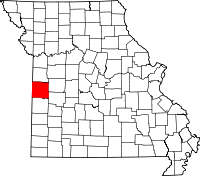Merwin, Missouri
| Merwin, Missouri | |
|---|---|
| Village | |
 Location of Merwin, Missouri | |
| Coordinates: 38°24′18″N 94°35′24″W / 38.40500°N 94.59000°WCoordinates: 38°24′18″N 94°35′24″W / 38.40500°N 94.59000°W | |
| Country | United States |
| State | Missouri |
| County | Bates |
| Area[1] | |
| • Total | 0.15 sq mi (0.39 km2) |
| • Land | 0.15 sq mi (0.39 km2) |
| • Water | 0 sq mi (0 km2) |
| Elevation | 899 ft (274 m) |
| Population (2010)[2] | |
| • Total | 58 |
| • Estimate (2012[3]) | 57 |
| • Density | 386.7/sq mi (149.3/km2) |
| Time zone | Central (CST) (UTC-6) |
| • Summer (DST) | CDT (UTC-5) |
| FIPS code | 29-47540[4] |
| GNIS feature ID | 0722244[5] |
Merwin is a village in Bates County, Missouri, United States. The population was 58 at the 2010 census.
History
Merwin was named for James G. Merwin, a railroad promoter.[6]
Geography
Merwin is located at 38°24′18″N 94°35′24″W / 38.40500°N 94.59000°W (38.404972, -94.590084).[7]
According to the United States Census Bureau, the village has a total area of 0.15 square miles (0.39 km2), all of it land.[1]
Demographics
2010 census
As of the census[2] of 2010, there were 58 people, 25 households, and 16 families residing in the village. The population density was 386.7 inhabitants per square mile (149.3/km2). There were 31 housing units at an average density of 206.7 per square mile (79.8/km2). The racial makeup of the village was 96.6% White, 1.7% from other races, and 1.7% from two or more races. Hispanic or Latino of any race were 1.7% of the population.
There were 25 households of which 28.0% had children under the age of 18 living with them, 40.0% were married couples living together, 12.0% had a female householder with no husband present, 12.0% had a male householder with no wife present, and 36.0% were non-families. 32.0% of all households were made up of individuals and 8% had someone living alone who was 65 years of age or older. The average household size was 2.32 and the average family size was 2.69.
The median age in the village was 45 years. 24.1% of residents were under the age of 18; 6.8% were between the ages of 18 and 24; 18.9% were from 25 to 44; 29.3% were from 45 to 64; and 20.7% were 65 years of age or older. The gender makeup of the village was 53.4% male and 46.6% female.
2000 census
As of the census[4] of 2000, there were 83 people, 32 households, and 22 families residing in the village. The population density was 572.7 people per square mile (228.9/km²). There were 33 housing units at an average density of 227.7 per square mile (91.0/km²). The racial makeup of the village was 87.95% White, and 12.05% from two or more races.
There were 32 households out of which 43.8% had children under the age of 18 living with them, 56.3% were married couples living together, 9.4% had a female householder with no husband present, and 31.3% were non-families. 28.1% of all households were made up of individuals and 15.6% had someone living alone who was 65 years of age or older. The average household size was 2.59 and the average family size was 3.14.
In the village the population was spread out with 32.5% under the age of 18, 3.6% from 18 to 24, 34.9% from 25 to 44, 19.3% from 45 to 64, and 9.6% who were 65 years of age or older. The median age was 36 years. For every 100 females there were 112.8 males. For every 100 females age 18 and over, there were 86.7 males.
The median income for a household in the village was $23,125, and the median income for a family was $26,250. Males had a median income of $28,750 versus $23,750 for females. The per capita income for the village was $10,038. There were 23.3% of families and 27.4% of the population living below the poverty line, including 29.2% of under eighteens and 57.1% of those over 64.
References
- ↑ 1.0 1.1 "US Gazetteer files 2010". United States Census Bureau. Retrieved 2012-07-08.
- ↑ 2.0 2.1 "American FactFinder". United States Census Bureau. Retrieved 2012-07-08.
- ↑ "Population Estimates". United States Census Bureau. Retrieved 2013-05-30.
- ↑ 4.0 4.1 "American FactFinder". United States Census Bureau. Retrieved 2008-01-31.
- ↑ "US Board on Geographic Names". United States Geological Survey. 2007-10-25. Retrieved 2008-01-31.
- ↑ Eaton, David Wolfe (1916). How Missouri Counties, Towns and Streams Were Named. The State Historical Society of Missouri. p. 285.
- ↑ "US Gazetteer files: 2010, 2000, and 1990". United States Census Bureau. 2011-02-12. Retrieved 2011-04-23.
| |||||||||||||||||||||||||||||
